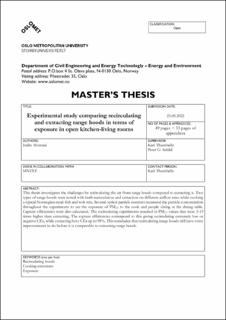| dc.contributor.advisor | Schild, Peter | |
| dc.contributor.advisor | Thunshelle, Kari | |
| dc.contributor.author | Alvestad, Iselin | |
| dc.date.accessioned | 2022-10-03T11:06:21Z | |
| dc.date.available | 2022-10-03T11:06:21Z | |
| dc.date.issued | 2022 | |
| dc.identifier.uri | https://hdl.handle.net/11250/3023323 | |
| dc.description.abstract | This thesis investigates the challenges by recirculating the air from range hoods compared to extracting it. Two types of range hoods were tested with both recirculation and extraction on different airflow rates while cooking a typical Norwegian meal: fish and wok mix. Several optical particle counters measured the particle concentration throughout the experiments to see the exposure of PM2.5 to the cook and people sitting at the dining table. Capture efficiencies were also calculated. The recirculating experiments resulted in PM2.5 values that were 3-19 times higher than extracting. The capture efficiencies correspond to this giving recirculating extremely low or negative CEs, while extracting have CEs up to 98%. This concludes that recirculating range hoods still have some improvements to do before it is comparable to extracting range hoods. | en_US |
| dc.language.iso | eng | en_US |
| dc.publisher | OsloMet - storbyuniversitetet | en_US |
| dc.relation.ispartofseries | MAEN;2022 | |
| dc.subject | Recirculating hoods | en_US |
| dc.subject | Cooking emissions | en_US |
| dc.subject | Exposure | en_US |
| dc.title | Experimental study comparing recirculating and extracting range hoods in terms of exposure in open kitchen-living rooms | en_US |
| dc.type | Master thesis | en_US |
| dc.description.version | publishedVersion | en_US |
